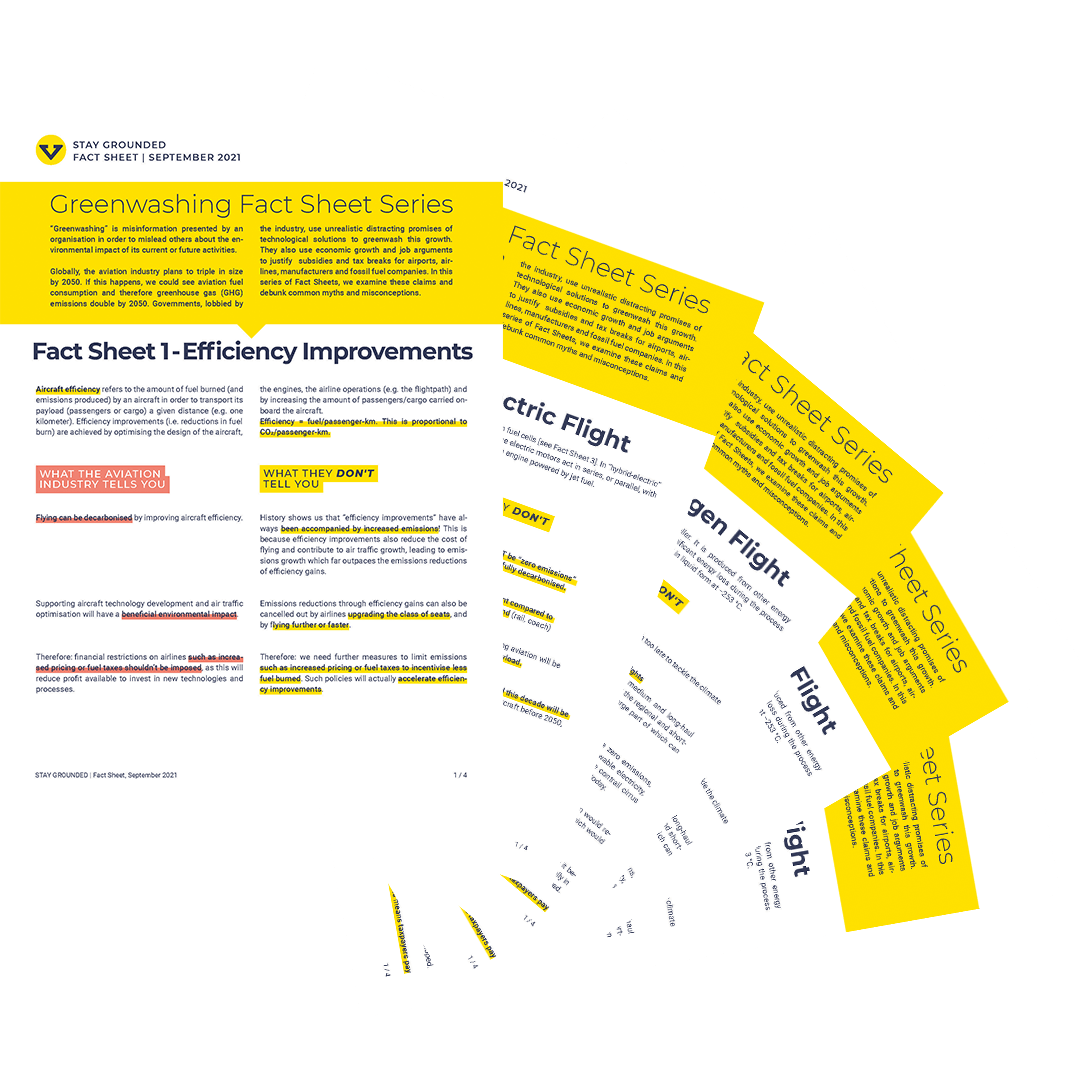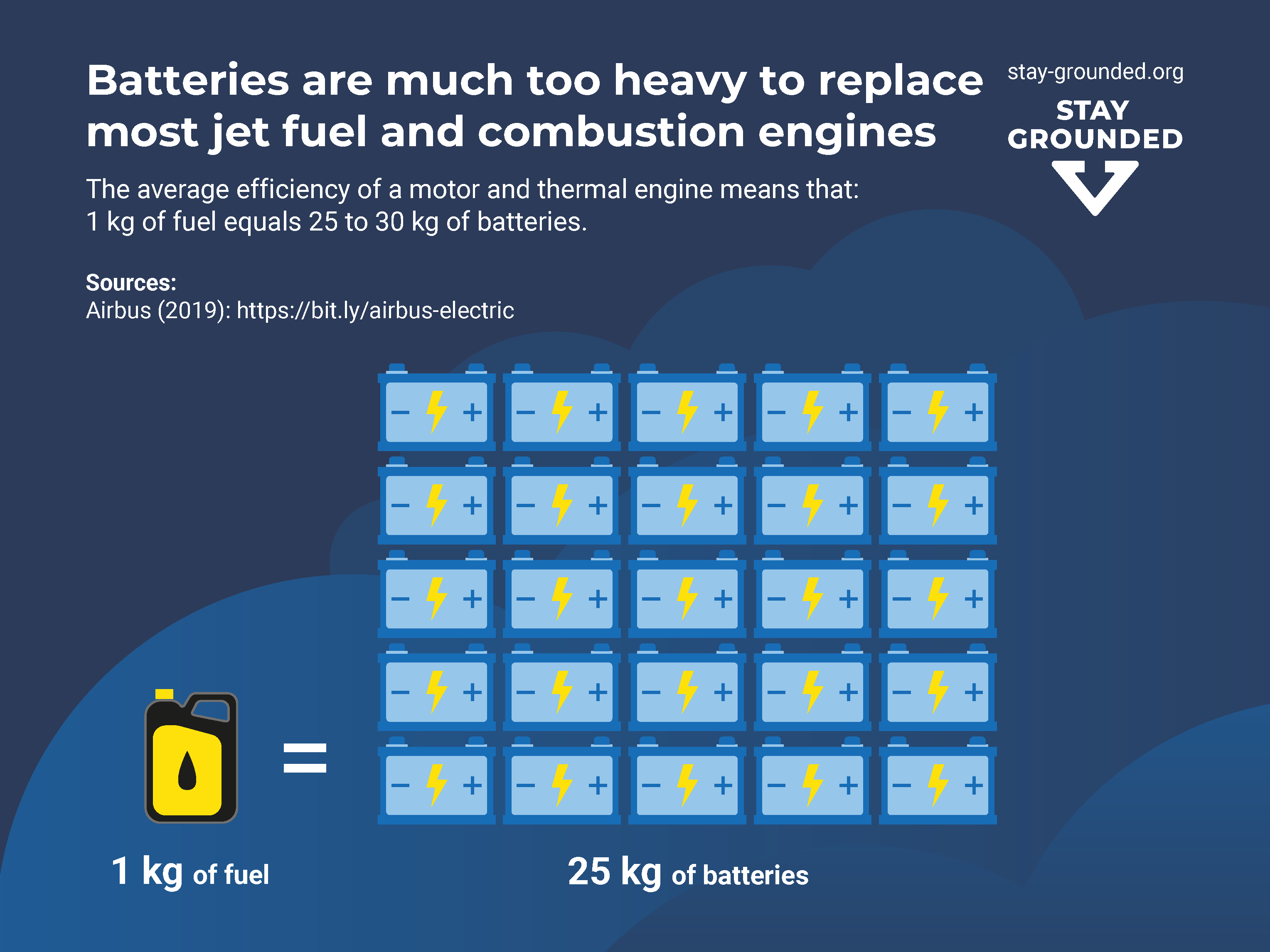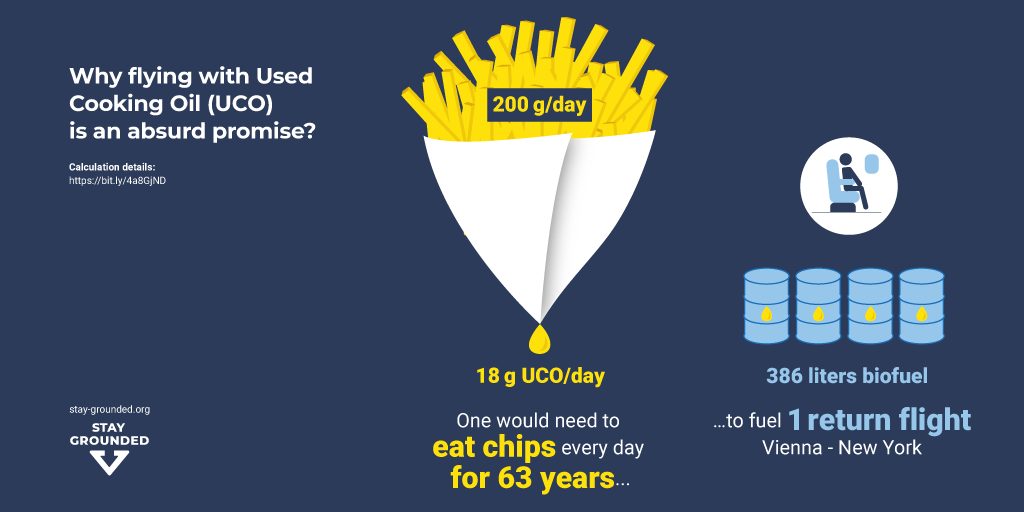SERIE DE HOJAS INFORMATIVAS SOBRE EL «GREENWASHING»
What the aviation industry tells you and what they DON’T tell you
What we need to know about decarbonisation promises and false solutions
By taking a closer look at what the industry tells us and what they don’t tell us, in our new fact sheet series we debunk common misconceptions and look behind the green curtain of their promises

Read here an outlook and summary of the fact sheets:
Click below to download the fact sheets or read online summaries further below.
- Summary
- Efficiency
- Electric Flight
- Hydrogen
- Biofuels
- E-fuels
- Net Zero
- Carbon Offsets
- Negative Emissions Technologies
Summary: Aviation Greenwash vs. Reality
“Greenwashing” is misinformation intended to mislead others about the environmental impact of activities.
Globally, the aviation sector plans to triple in size by 2050 which would see aviation fuel consumption and therefore greenhouse gas (GHG) emissions, double.
Governments, lobbied by the sector, use unrealistic and distracting promises of technological solutions and offsets to greenwash this growth. They also use economic growth and job arguments to justify subsidies and tax breaks for airports, airlines, manufacturers and fossil fuel companies.
In our series of Fact Sheets, we examine these claims and debunk common myths and misconceptions.
Mejoras en la eficiencia
La eficiencia de las aeronaves se refiere a la cantidad de combustible quemado (y las emisiones producidas) por una aeronave para transportar su carga útil (pasajeros o carga) una distancia determinada (por ejemplo, un kilómetro). Las mejoras de eficiencia (es decir, la reducción del consumo de combustible) se logran optimizando el diseño de las aeronaves, los motores, las operaciones de la aerolínea (por ejemplo, la trayectoria de vuelo) y aumentando la cantidad de pasajeros/carga transportada a bordo de la aeronave.
El CO2/pasajero-km es proporcional a la eficiencia (combustible/pasajero-km).

Vuelo eléctrico

Vuelo de hidrógeno

Biocombustibles
Aviation biofuel is a liquid hydrocarbon fuel that can be used with existing aircraft blended with fossil kerosene. Like e-fuel (see Fact Sheet #5 Synthetic e-fuels), the sector calls it a “Sustainable Aviation Fuel” (SAF), which it is not, as we demonstrate in this fact sheet.
Biofuels for aviation are produced from biomass sources and hydrogen. First generation biofuels use agricultural crops. Due to their drawbacks, the sector is mandated by European legislation to use so-called “waste and residues”, either industrial, food, farm and forestry.
At present, the only aviation biofuel of this kind proven at scale, HEFA (Hydrogenated Esters and Fatty Acids), are made from feedstocks labeled as “used cooking oils” or “animal fats” (from slaughterhouse operations).
However there is rampant mislabeling of these feedstocks, including, for example, virgin palm oil labeled as used cooking oil. So-called “advanced biofuels” from lignocellulosic biomass (wood, straw…) have never been and are unlikely to ever be technically proven at scale. Hydrogen, although rarely mentioned, is required in all certified aviation biofuel production processes, but is today mostly produced from fossil fuels (see Fact Sheet #3 Hydrogen flight).

Electrocombustibles sintéticos
Los combustibles alternativos para aviones o los llamados «Combustibles de Aviación Sostenibles» (SAF) son combustibles líquidos de hidrocarburos que pueden utilizarse con los aviones existentes en lugar del queroseno producido a partir de combustibles fósiles. La premisa de la industria de la sostenibilidad de estos combustibles es crear el combustible utilizando CO2 tomado de la atmósfera, en lugar de utilizar combustibles fósiles extraídos de las profundidades del subsuelo que luego emitirán CO2 adicional a la atmósfera cuando se quemen. El argumento es que la mezcla de estos combustibles con combustibles fósiles reduciría así las emisiones.
El combustible alternativo para aviones se puede clasificar en dos variedades:
- Biocombustibles producidos a partir de fuentes de biomasa (véase la ficha informativa 4)
- Electrocombustibles sintéticos (e-fuels) producidos a partir de electricidad (explicados a continuación)
Los electrocombustibles sintéticos o «e-fuels» se pueden producir combinando hidrógeno con carbono para crear un hidrocarburo líquido. Para minimizar las emisiones, el hidrógeno debe extraerse del agua mediante electrólisis utilizando energías renovables; y el carbono debe extraerse del aire mediante un proceso llamado «Captura directa de aire» (DAC). A continuación, se pueden combinar para formar un combustible de hidrocarburo utilizando la síntesis de Fischer-Tropsch (FT)1. Estos últimos procesos también deben ser alimentados con energía renovable.
Los e-combustibles también se conocen como combustibles «Synfuels» o Power-to-Liquid (PtL). Los e-combustibles, al igual que los biocombustibles, son combustibles directos que podrían mezclarse con el combustible fósil convencional para aviones (queroseno) y ser utilizados por la flota existente.
A primera vista, los e-fuels parecen ser el arma definitiva para descarbonizar la aviación: deberían poder utilizarse directamente en todo tipo de aviones actuales, sea cual sea su autonomía; no sufren limitaciones de materia prima porque se fabrican a partir del agua y el aire, que son recursos muy abundantes; Y la electricidad necesaria podría generarse a su vez a partir del sol y el viento, que son energías muy abundantes.
Entonces, ¿por qué todavía no hay aviones propulsados por estos combustibles y muy pocos durante otros diez años más o menos?
Principalmente porque la producción de e-fuels es extremadamente derrochadora de energía.
Privaría a otros sectores que necesitan descarbonizarse, ya que no habrá suficiente energía renovable disponible para satisfacer todas las necesidades en las próximas décadas.
También porque se trata de una nueva industria que comienza casi desde cero, que todavía necesita completar el desarrollo de procesos y establecer un sector completamente nuevo.

Cero neto y neutralidad de carbono
Alcanzar los objetivos de «cero emisiones netas» es actualmente el objetivo central establecido en casi todas las estrategias climáticas, ya sea de la industria o del gobierno. Por su parte, el sector de la aviación se ha comprometido a alcanzar las cero emisiones netas deCO2 en 2050.
Según el IPCC1, las cero emisiones netas deCO2 se logran cuando las emisiones antropógenas deCO2 restantes se equilibran a nivel mundial con las absorciones antropogénicas de CO2. Esto significa que con el concepto de cero neto, todavía se permiten algunas emisiones «difíciles de reducir», siempre que se eliminen de la atmósfera cantidades equivalentes deCO2. Las cero emisiones netas deCO2 también se conocen como neutralidad de carbono. Cuando se tienen en cuenta todos los gases de efecto invernadero, esto se conoce como emisiones netas cero.
Se promete equilibrar las emisiones residuales a través de la eliminación de dióxido de carbono; se trata de una serie de procesos que eliminan elCO2 de la atmósfera, además de la eliminación mediante procesos naturales del ciclo del carbono. Puede lograrse mediante el aumento de los sumideros biológicos o geoquímicos de CO2 o mediante el uso de procesos industriales para capturar CO2. La eliminación de dióxido de carbono es uno de los dos tipos de compensaciones de carbono2 , además de los créditos por emisiones «evitadas».

Compensaciones de carbono
Una compensación de carbono es una «unidad» de emisiones de gases de efecto invernadero (GEI) que una entidad (supuestamente) reduce, evita o elimina de la atmósfera y otra entidad la compra para tratar de compensar sus propias emisiones.
Las compensaciones de carbono juegan un papel importante en muchos de los planes actuales de reducción de emisiones y pueden ser parte de esquemas de tope y comercio como en California.
Sobre la base de proyectos que se encuentran principalmente en el Sur Global, los estados y las empresas (principalmente en el Norte Global) están utilizando las compensaciones para lograr el cumplimiento.
La mayoría de las operaciones se realizan en mercados de carbono específicos.
El sector de la aviación hace un uso extensivo de la compensación de carbono.
El organismo responsable de la ONU, la OACI (Organización de Aviación Civil Internacional), ha acordado un plan común para los vuelos internacionales llamado CORSIA (Esquema de Compensación y Reducción de Carbono para la Aviación Internacional).
Algunos países o regiones tienen esquemas de compensación específicos
para vuelos dentro de sus fronteras. A los viajeros aéreos también se les puede ofrecer comprar compensaciones cuando compran boletos de aerolíneas o agencias de viajes, o incluso pueden venir incluidos en su paquete. Los aeropuertos también están utilizando directamente las compensaciones para cubrir las emisiones terrestres y utilizarlas como incentivo para que las personas utilicen su «aeropuerto verde», independientemente de las emisiones de los aviones.

Tecnologías de Emisiones Negativas
Al igual que la mayoría de los gobiernos y muchos sectores, el sector de la aviación tiene el objetivo de emisiones «netas cero» para 2050. Esto no cumplirá con los objetivos del Acuerdo de París sin ambiciosas reducciones a corto plazo de las emisiones que parecen incapaces o reacios a cumplir (ver Hoja informativa # 6: Cero neto y neutralidad de carbono). Justifican la continuación de altos niveles de emisión, o incluso el aumento de las emisiones, planificando el uso de emisiones negativas [también conocidas como «Eliminación de Dióxido de Carbono» (CDR) o «Eliminación de Gases de Efecto Invernadero» (GGR)] en un futuro bastante lejano. Sin embargo, como se explica en esta hoja informativa: esta es una estrategia peligrosa e imprudente.
Las «Tecnologías de Emisiones Negativas» (NETs) se refieren a los procesos industriales (en lugar de los procesos naturales como el crecimiento de los árboles) que eliminan activamente el dióxido de carbono (CO2) capturándolo de la atmósfera y almacenándolo, supuestamente de forma permanente. Las tecnologías usualmente propuestas son: (1)
- Captura y almacenamiento directo de carbono en el aire (DACCS): captura de CO2 directamente de la atmósfera a través de procesos industriales y lo almacena bajo tierra.
- Bioenergía con Captura y Almacenamiento de Carbono (BECCS): produce energía a partir de biomasa y luego almacena parte del carbono resultante bajo tierra o en el suelo.

